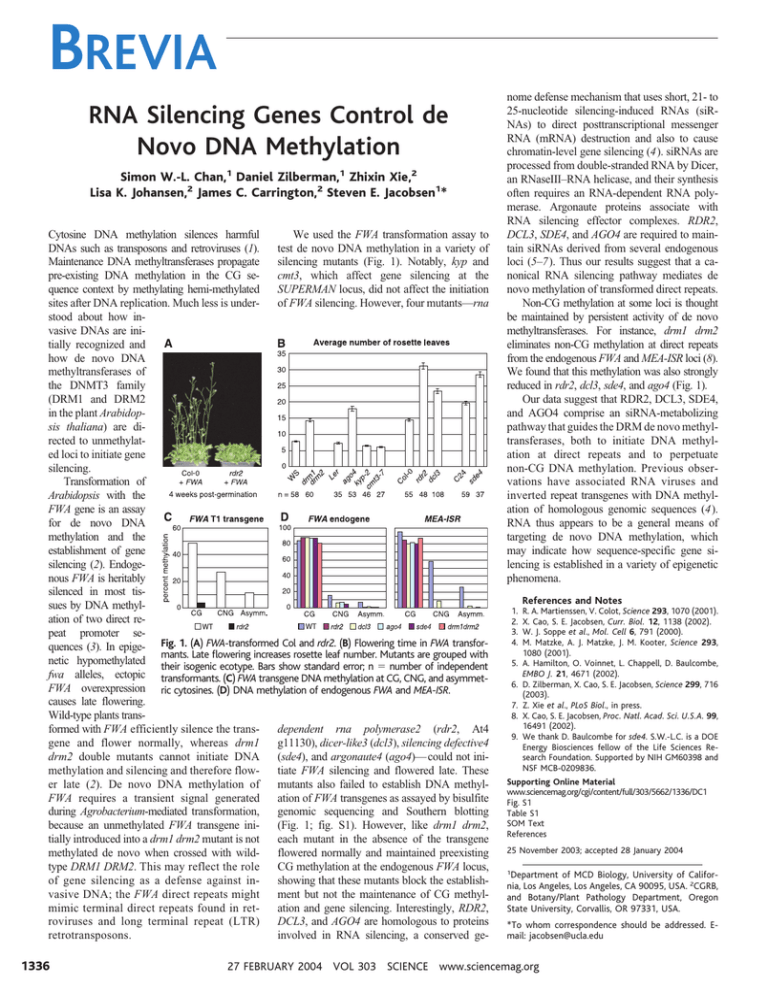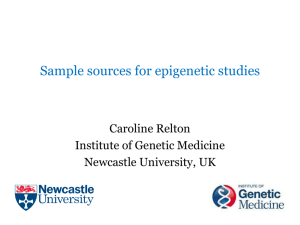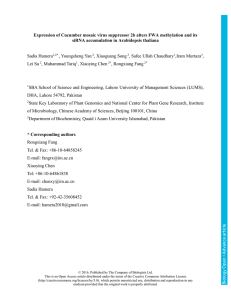RNA Silencing Genes Control de Novo DNA Methylation
advertisement

BREVIA RNA Silencing Genes Control de Novo DNA Methylation Simon W.-L. Chan,1 Daniel Zilberman,1 Zhixin Xie,2 Lisa K. Johansen,2 James C. Carrington,2 Steven E. Jacobsen1* Cytosine DNA methylation silences harmful We used the FWA transformation assay to DNAs such as transposons and retroviruses (1). test de novo DNA methylation in a variety of Maintenance DNA methyltransferases propagate silencing mutants (Fig. 1). Notably, kyp and pre-existing DNA methylation in the CG secmt3, which affect gene silencing at the quence context by methylating hemi-methylated SUPERMAN locus, did not affect the initiation sites after DNA replication. Much less is underof FWA silencing. However, four mutants—rna stood about how invasive DNAs are initially recognized and how de novo DNA methyltransferases of the DNMT3 family (DRM1 and DRM2 in the plant Arabidopsis thaliana) are directed to unmethylated loci to initiate gene silencing. Transformation of Arabidopsis with the FWA gene is an assay for de novo DNA methylation and the establishment of gene silencing (2). Endogenous FWA is heritably silenced in most tissues by DNA methylation of two direct repeat promoter sequences (3). In epige- Fig. 1. (A) FWA-transformed Col and rdr2. (B) Flowering time in FWA transformants. Late flowering increases rosette leaf number. Mutants are grouped with netic hypomethylated their isogenic ecotype. Bars show standard error; n ⫽ number of independent fwa alleles, ectopic transformants. (C) FWA transgene DNA methylation at CG, CNG, and asymmetFWA overexpression ric cytosines. (D) DNA methylation of endogenous FWA and MEA-ISR. causes late flowering. Wild-type plants transformed with FWA efficiently silence the transdependent rna polymerase2 (rdr2, At4 gene and flower normally, whereas drm1 g11130), dicer-like3 (dcl3), silencing defective4 drm2 double mutants cannot initiate DNA (sde4), and argonaute4 (ago4)— could not inimethylation and silencing and therefore flowtiate FWA silencing and flowered late. These er late (2). De novo DNA methylation of mutants also failed to establish DNA methylFWA requires a transient signal generated ation of FWA transgenes as assayed by bisulfite during Agrobacterium-mediated transformation, genomic sequencing and Southern blotting because an unmethylated FWA transgene ini(Fig. 1; fig. S1). However, like drm1 drm2, tially introduced into a drm1 drm2 mutant is not each mutant in the absence of the transgene methylated de novo when crossed with wildflowered normally and maintained preexisting type DRM1 DRM2. This may reflect the role CG methylation at the endogenous FWA locus, of gene silencing as a defense against inshowing that these mutants block the establishvasive DNA; the FWA direct repeats might ment but not the maintenance of CG methylmimic terminal direct repeats found in retation and gene silencing. Interestingly, RDR2, roviruses and long terminal repeat (LTR) DCL3, and AGO4 are homologous to proteins retrotransposons. involved in RNA silencing, a conserved ge- 1336 nome defense mechanism that uses short, 21- to 25-nucleotide silencing-induced RNAs (siRNAs) to direct posttranscriptional messenger RNA (mRNA) destruction and also to cause chromatin-level gene silencing (4). siRNAs are processed from double-stranded RNA by Dicer, an RNaseIII–RNA helicase, and their synthesis often requires an RNA-dependent RNA polymerase. Argonaute proteins associate with RNA silencing effector complexes. RDR2, DCL3, SDE4, and AGO4 are required to maintain siRNAs derived from several endogenous loci (5–7). Thus our results suggest that a canonical RNA silencing pathway mediates de novo methylation of transformed direct repeats. Non-CG methylation at some loci is thought be maintained by persistent activity of de novo methyltransferases. For instance, drm1 drm2 eliminates non-CG methylation at direct repeats from the endogenous FWA and MEA-ISR loci (8). We found that this methylation was also strongly reduced in rdr2, dcl3, sde4, and ago4 (Fig. 1). Our data suggest that RDR2, DCL3, SDE4, and AGO4 comprise an siRNA-metabolizing pathway that guides the DRM de novo methyltransferases, both to initiate DNA methylation at direct repeats and to perpetuate non-CG DNA methylation. Previous observations have associated RNA viruses and inverted repeat transgenes with DNA methylation of homologous genomic sequences (4). RNA thus appears to be a general means of targeting de novo DNA methylation, which may indicate how sequence-specific gene silencing is established in a variety of epigenetic phenomena. 1. 2. 3. 4. References and Notes R. A. Martienssen, V. Colot, Science 293, 1070 (2001). X. Cao, S. E. Jacobsen, Curr. Biol. 12, 1138 (2002). W. J. Soppe et al., Mol. Cell 6, 791 (2000). M. Matzke, A. J. Matzke, J. M. Kooter, Science 293, 1080 (2001). 5. A. Hamilton, O. Voinnet, L. Chappell, D. Baulcombe, EMBO J. 21, 4671 (2002). 6. D. Zilberman, X. Cao, S. E. Jacobsen, Science 299, 716 (2003). 7. Z. Xie et al., PLoS Biol., in press. 8. X. Cao, S. E. Jacobsen, Proc. Natl. Acad. Sci. U.S.A. 99, 16491 (2002). 9. We thank D. Baulcombe for sde4. S.W.-L.C. is a DOE Energy Biosciences fellow of the Life Sciences Research Foundation. Supported by NIH GM60398 and NSF MCB-0209836. Supporting Online Material www.sciencemag.org/cgi/content/full/303/5662/1336/DC1 Fig. S1 Table S1 SOM Text References 25 November 2003; accepted 28 January 2004 1 Department of MCD Biology, University of California, Los Angeles, Los Angeles, CA 90095, USA. 2CGRB, and Botany/Plant Pathology Department, Oregon State University, Corvallis, OR 97331, USA. *To whom correspondence should be addressed. Email: jacobsen@ucla.edu 27 FEBRUARY 2004 VOL 303 SCIENCE www.sciencemag.org





